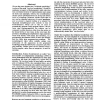Free Online Productivity Tools
i2Speak
i2Symbol
i2OCR
iTex2Img
iWeb2Print
iWeb2Shot
i2Type
iPdf2Split
iPdf2Merge
i2Bopomofo
i2Arabic
i2Style
i2Image
i2PDF
iLatex2Rtf
Sci2ools
COLING
1992
1992
A Logic Programming View of Relational Morphology
he more abstract term "relational morphology" in place of tile usual "two-level morphology" in order to emphasize an aspect of Koskenniemi's work which has been overlooked in favor of implementation issues using the finite state paradigm, namely, that a mathematical relation can be specified between the lexical and surface levels of a language. Relations, whether finite state or not, can be computed using any of several paradigms, and we present a logical reading of a notation for relational morphological rules (similar to that of Koskenniemi's) which can in fact be used to automatically generate Prolog program clauses. Like die finite state implementations, the relation can be computed in either direction, either from the surface to the lexieal level, or vice versa. At rite very least, this provides a morphological complement to logic grammars which deal mainly with syntax and semantics, in a programming environment which is more user-friendly than the f...
| Added | 07 Nov 2010 |
| Updated | 07 Nov 2010 |
| Type | Conference |
| Year | 1992 |
| Where | COLING |
| Authors | Harvey Abramson |
Comments (0)

